As an Amazon Associate, this site earns commissions from qualifying purchases. For more details, click here.
Found in many Southeast Asian countries, nepenthes gracilis is notable for its long, vibrant pitchers. These specialized in insect traps are either green or speckled red, sometimes dark and in other variants bright. N. gracilis is a common lowland nepenthes and is easy to grow under the right conditions. You can use the following guide for its cultivation.
For the best results, nepenthes gracilis should be grown in bright, indirect light at 68-85 F degrees. You have to use rainwater or purified water to keep the soil moist. This plant prefers high humidity and neutral to slightly acidic substrates.
Nepenthes Gracilis Care Sheet
| Soil | 1:1 peat and perlite |
| Water | Rainwater, purified, distilled |
| Light | 6-8 hours bright, indirect light, grow lights are fine |
| Food | |
| Temperature | 68-85 F (20-30 C) |
| Humidity | 80-100% |
| Dormancy | No |
| Propagation | Stem and leaf cutting |
Soil
Nepenthes gracilis only grows in low nutrient soil. The materials must be free from any rich ingredients to be suitable for carnivorous plants. A good example of this is the Leaves and Soil Mix which can b used with nepenthes or sarracenia.
Peat and perlite is the most commonly used soil mix for n. gracilis. The mix is usually in equal parts but others use a 2:1 or 3:1 ratio, with more peat than perlite.
Other soil combinations are sphagnum moss and silica sand, peat and silica sand or vermiculite and perlite. Some soil mixtures include orchid bark, charcoal, pumice, lava rock or tree fern fiber.
Pitcher plants can die for various reasons and using the wrong soil is one of them. Since carnivorous plants already get nutrients from insects, there is no need to add compost or fertilizer. Do not use regular potting soil with n. gracilis or any carnivorous plant.
Pot Container
Nepenthes gracilis are usually shipped in a 3 inch pot. However the plant can outgrow this so a 5 inch container is better.
If you have a small variant a 3 inch pot might be enough. But healthy n. gracilis can expand in the right conditions. If your nepenthes came in a small container, repot with a larger one.
You can also grow n. gracilis in a terrarium. Its compact size makes it suitable for a tight container so it should work. However you have to provide light and heat sources as well as ventilation. You also have to feed the plant by hand since it will have hard time capturing prey.
Nepenthes gracilis are usually repotted every two years. But you should do it sooner if the plant is growing quickly. Their roots need room to grow so a bigger container will be helpful. Whether you choose a pot, hanging basket or terrarium, the plant must get sufficient light, humidity and water to thrive.
Water
Lowland pitcher plants like nepenthes gracilis need a lot of water. Spray the plant thoroughly until the soil is moist. Use only purified, distilled or rainwater and be careful not to drench the plant.
These pitcher plants do not like the tray method. It is often used with Venus flytraps, sundews and sarracenia, but not here. While n. gracilis benefits from frequent watering, sitting the plant on a tray full of water may be too much.
During summer you have to keep the plant wet and warm, lots of bright, indirect light and constantly moist soil. Using a spray bottle to water from the top is usually enough.
If you keep n. gracilis in the ideal temperature range, there is no need for bottom watering. If it reaches the high 90s or 100s, the tray method is acceptable. Do keep a watch to see how n. gracilis responds.
No matter which method you go with, steer clear of tap water. They contain minerals which are hazardous to plants. It is safer to use spring water or purified / distilled water. Rainwater is going to work as well.
Light
Nepenthes gracilis prefers bright, indirect light or partial sunlight. Indirect light means the plant is located in a shady spot but the area gets full sunlight. Partial sunlight means the plant receives full light only at certain times of the day.
To provide indirect light for nepenthes gracilis, find a sunny location. This can be a windowsill or somewhere outdoors. Position the plant behind another plant or another object so it is partially shaded. You can also use Sansi LED Grow Lights for indoor cultivation. Keep the light on for several hours a day or use it in conjunction with natural light.
To provide partial sunlight, look for an area in your home that receives full light at specific times of the day. For instance, you may have a window that gets partial light in the morning and full light in the afternoon.
Once you have chosen a spot, observe your n. gracilis for the next few days. You should be able to tell if it is too little, too much or the right amount of light. Pitchers turn black for a variety of causes, and one of those is too much light. The leaves become dry and crispy as do the pitchers. You need to water more often and relocate the plant so it is under partial indirect light.
Temperature
The optimum day temperature for nepenthes gracilis is 68-85 F (20-30 C). At night, the minimum should be 50 F (10 C).
Most of the focus is on sunlight, but temperature is just as important for lowland nepenthes. These are tropical pitcher plants so they prefer warm, humid conditions.
If you live in a warm zone you can grow n. gracilis outdoors the entire year. In colder regions you have to cultivate it indoors or a terrarium. Because this plant is small, a compact unit will be more than enough.
Because temperature and light affect each other, you have to make sure neither is too high or too low. A few degrees higher or lower than the ideal range is not going to kill your nepenthes. But prolonged exposure could slow growth.
Humidity
Keep the humidity at 80-100%. Nepenthes gracilis likes bright light combined with a wet, humid atmosphere. Some variants may adapt to lower humidity but in general you should aim for no less than 80%.
Just like temperature, lower humidity is not fatal. Some of these plants can survive in 50% levels. But there is a difference between surviving and flourishing. If you want thriving, vibrant nepenthes, keep it in high humidity.
A humidifier or fogger can be very effective in raising humidity. Sometimes watering more often is enough to increase moisture. During summer or periods of low humidity however, a humidifier like the MOVTIP is often the best option.
Nutrition and Feeding
Nepenthes gracilis eats crickets, mealworms, yellow jackets, gnats, flies, mosquitoes, moths and other insects. They also eat fish pellets.
No matter what you feed it, the process is the same. Crush the food into small bits and add a droplet or two of water to soften. Put a small amount of the food in the pitcher.
You can feed just a couple of pitchers and that is fine. Once you drop the food, the plant will release its digestive enzymes to dissolve it.
If you grow nepenthes hookeriana or other pitcher plants, you will be familiar with how they trap and consume prey. Nepenthes gracilis works the same way but in addition it has a lit on top of its pitcher.
Insects are drawn to the lid, but if a water droplet falls on it, they lose balance and fall into the trap. These lids also reduce the amount of water that falls into the pitchers during a downpour. Other pitcher plants with lids also have the same function.
Dormancy
Nepenthes gracilis is a tropical pitcher plant and does not go dormant in winter. You have to keep this plant in a constantly warm, humid environment.
N. gracilis can tolerate 50 F (10 C) at night, but anything lower is risky. If you have cold winters the plant has to be grown indoors. Lowland tropical pitcher plants need warmth during the day and will not last without them.
If the weather in your area is not favorable to nepenthes gracilis, use a terrarium or another enclosure. Provide a heat source to keep the temperature at 68-85 F throughout the year.
Once set up you just need to perform maintenance. One of the benefits of no dormancy pitcher plants is you can propagate anytime. You can also prune its leaves at any point.

My fascination with carnivorous plants began many, many years ago with Venus Fly Traps. Now I am more than happy to impart what I know with other enthusiasts and those who are curious about meat eating plants.



